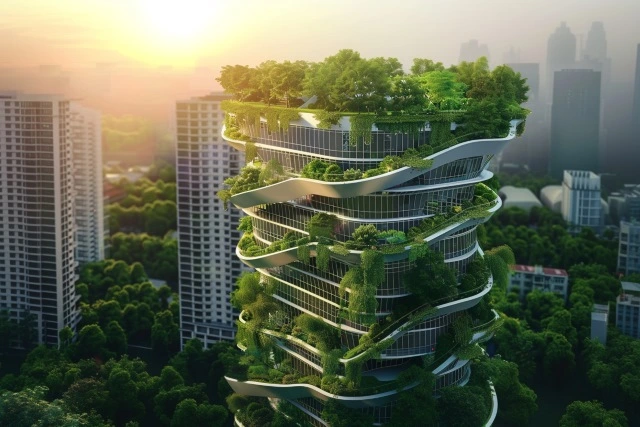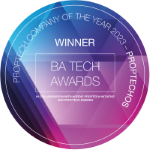Construction is about much more than putting a roof over our heads. Building design at its best is considered by many to be a form of art, with renowned 21st-century architects akin to Renaissance painters. Structures have been viewed as landmarks and symbols of local and national identity for millennia, from Rome’s historic Colosseum to New York’s iconic One World Trade Center.
Buildings can also act as beacons of sustainability. In 2015, the 632m-tall Shanghai Tower became the tallest building platinum-certified by the U.S. Green Building Council under its LEED (Leadership in Energy and Environmental Design) system. The world’s third-tallest tower is an icon of China’s most populous city and a ‘green building’ with Environmental, social, and governance (ESG) goals at its core.
Green buildings have become increasingly important given the construction sector’s energy consumption and CO2 emission record. Sustainable architecture practices have grown since the 1970s when a global fuel crisis necessitated greater energy efficiency in commercial developments. Today, there are more than 100,000 LEED-certified structures worldwide, demonstrating a global commitment to ESG targets.
But what does this look like for future commercial real estate (CRE)? This article will look at the developments in green building design over the last 50 years, and how innovation in the sector drives a stronger ESG focus across the industry.
What makes a building green?
For the most part, a building is only as sustainable as the energy that powers it. As of 2022, around a quarter (22%) of energy consumed in the European Union came from renewable sources. While architects and civil engineers continue to innovate building design, the sector’s transition from fossil fuels to clean energy sources will be crucial to achieving Net Zero in the long term.
Positive energy buildings
However, positive energy buildings (PEBs) have grown in popularity as a solution to high consumption. These structures generate more power than they consume; they go beyond net zero by regenerating power through energy and heat recovery systems, on top of their own energy generation through technologies like wind turbines or solar panels.
The Heliotrope building in Freiburg, Germany, was the first of its kind, and today, there are around 2,500 of these buildings globally. The EU’s EXCESS project aims to demonstrate the capability of such technologies to increase their usage across Europe. The Kalasatama smart district in Helsinki, Finland, is one example.
Sustainable materials in construction
Green building design is also dependent on the use of sustainable materials. With growing urbanization and 80% of the world’s population expected to live in cities by 2050, reducing construction’s carbon footprint will be crucial. While sustainable materials have been used for centuries, harnessing their use in modern construction is often a challenge for architects – not to mention the added cost to the design and build.
However, materials such as glass, structural timber, and stone are still widely used in the construction of green buildings and will be important features in future construction practices. Landowners and developers are willing to pay a premium for building leases with sustainable credentials, so incorporating green design into construction makes economic sense.
Smart building technologies
Another key aspect of green building design is the computer-aided technology that manages key systems within its walls. Building management systems (BMS) are continually evolving, and AI technology is now a prominent feature in the day-to-day operation of core systems, including lighting, heating, and ventilation. Integrated software using the Internet of Things (IoT) makes it easier to connect key systems to improve energy efficiency and reduce consumption.
Completed in 2014, The Edge in Amsterdam is considered the smartest in the world. Ahead of its time, the 40,000 sq m office building has over 28,000 sensors that track and predict occupancy usage, allowing managers to adjust energy consumption according to demand. Its 15-storey glass atrium traps sunlight and regenerates power using solar panels. It even has a gym that harnesses energy from exercise stations and puts the power back into the grid!
The future of green buildings
Despite all of these technological developments and investments in green technology, the building industry continues to emit record-breaking levels of CO2.
Inger Andersen, Executive Director of the United Nations Environment Programme (UNEP), explains, ” The buildings sector represents 40% of Europe’s energy demand, 80% of it from fossil fuels. This makes the sector an area for immediate action, investment, and policies to promote short—and long-term energy security.”
While the sector has made great strides in improving the operational efficiency of structures with smart tech, the rate of development continues to increase. By 2030, it’s estimated that the world will have 298 billion sq m of building floor space. So what else can be done?
Cross-laminated timber
One key aspect of green building construction gaining traction in the 2020s is cross-laminated timber (CLT). Wooden construction isn’t typically considered safe or eco-friendly, but mass timber sourced from sustainable forests is becoming increasingly popular in construction. It is a more carbon-friendly alternative to concrete and can be produced to meet international fire safety standards.
Embodied carbon
The future of green building construction will be defined by how well the sector can reduce carbon emissions associated with building materials and construction processes, which the industry defines as ‘embodied carbon.’ Reducing this begins at the procurement stage, and careful management is required to limit carbon consumption at all phases of a building’s construction.
Data-led technologies are emerging that carefully track carbon metrics across the development cycle to inform decisions on using materials during design and build. In 2021, RMI and Skanska U.S. produced a report demonstrating an embodied carbon savings potential of up to 46% in construction while adding just 1% to bottom-line costs.
Leveraging ProptechOS in Green Building Management
While the technology behind green building design becomes ever more advanced, the data behind such technology can become overwhelming for property managers. Those backed by the analysis of their portfolios and what is needed to reach their ESG goals will succeed and find it easiest to secure environmental benchmarking certifications against their buildings.
Whether you manage legacy infrastructure or state-of-the-art green buildings, we have created the ProptechOS framework as a comprehensive suite of energy-efficiency solutions for building owners and property managers to optimize their portfolios’ energy consumption.
ProptechOS’s Certify software automates building certification, making it quicker and easier for your portfolio to achieve accreditation from key industry benchmarkers, including GRESB and LEED certifications.
Your CRE business can sign up for a free trial today.

Per Karlberg
Per Karlberg, a distinguished technology executive, demonstrates deep expertise in the nexus of real estate, technology, and ESG. Holding advanced degrees from Lund University, and with key roles as CEO of our company and Co-Founder of ProptechOS, he has shaped the proptech field through significant contributions to real estate technology advancements. His instrumental work in co-authoring “The realestatecore ontology” has facilitated digital transformation and ESG breakthroughs in the real estate sector.
Read his full bio and information here.

